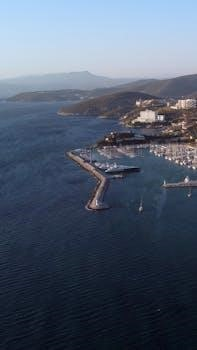The story of Noah’s Ark is a timeless tale that resonates across cultures. It speaks of divine judgment and salvation, featuring a unique vessel and incredible journey.
Brief Overview of the Noah’s Ark Story
The narrative begins with God observing the wickedness of humanity and deciding to cleanse the Earth with a great flood. However, one righteous man, Noah, found favor in God’s eyes. God instructed Noah to build an ark, a massive vessel capable of housing himself, his family, and pairs of every animal species. Noah diligently followed these instructions, constructing the ark and gathering the animals as commanded. Then, the flood came, covering the entire world and destroying all life except for those within the ark. The ark floated upon the waters for many days until the flood subsided. Finally, the ark landed on the mountains of Ararat, and Noah released the animals to repopulate the Earth. This story is a powerful illustration of faith, obedience, and God’s promise of renewal and is recounted in various religious traditions.

The Biblical Narrative
The story of Noah’s Ark is primarily found in the Book of Genesis. It details the reasons for the flood and God’s covenant with Noah.
God’s Decision to Flood the Earth
The biblical narrative explains that God observed the wickedness and corruption that had consumed humanity. Violence, injustice, and moral decay were rampant, leading to profound disappointment and grief in God’s heart. The earth, originally created as a paradise, had become marred by human sin. This pervasive evil had reached a point where God felt compelled to take drastic action. The narrative describes God’s deep sorrow and regret for having created humankind. It wasn’t a decision made lightly but a response to the overwhelming perversion of the world. This divine judgment was not intended as an act of random destruction but as a means to cleanse the earth and offer a fresh start, preserving a righteous lineage through Noah and his family. The flood was therefore a consequence of humanity’s choices, and God’s intention was to restore goodness to creation.
Noah’s Selection and Instructions
Amidst the pervasive wickedness, the Bible portrays Noah as a righteous and blameless man, finding favor in God’s eyes. Unlike his contemporaries, Noah lived a life dedicated to following God’s will, setting him apart. Consequently, God chose Noah to be the sole recipient of his warning and the instrument of salvation for his family and a remnant of creation. God’s instructions to Noah were explicit and detailed. He was commanded to construct a massive ark according to specific dimensions and materials. The ark was designed not as a boat for sailing but as a secure vessel capable of withstanding the catastrophic flood. Noah was also instructed to gather his family and pairs of every kind of animal, to ensure the continuation of life after the deluge. This divine mandate was a monumental task, requiring faith, obedience, and meticulous planning on Noah’s part.
Construction of the Ark
The construction of the ark was a monumental undertaking, requiring immense labor and dedication from Noah and his family. The biblical account specifies the ark’s dimensions, instructing it to be 300 cubits long, 50 cubits wide, and 30 cubits high, a massive structure by any standard. The ark was to be made of gopher wood and covered with pitch inside and out, ensuring its water-tightness. This wasn’t a typical ship designed for navigation but a floating vessel intended to withstand the forces of a devastating flood. The task likely took many years to complete, during which time Noah faced skepticism and ridicule from his neighbors. The ark’s construction was a testament to Noah’s unwavering faith and obedience to God’s commands, a tangible representation of his belief in the coming judgment. It was a project that demanded both physical effort and unwavering commitment to the divine plan.

Gathering the Animals
A key element of the narrative involves Noah’s task of gathering animals. He had to bring pairs of every creature, ensuring the continuation of life after the flood.
The Process of Collecting Animal Pairs
The Bible describes a miraculous event where animals came to Noah, suggesting a divine guidance in their collection. It wasn’t a matter of Noah trekking across the globe to capture creatures; rather, they approached him, seemingly drawn by an unseen force. This process highlights the extraordinary nature of the task and the divine intervention involved. The animals, both large and small, from every corner of the earth, were compelled to seek refuge on the Ark. This gathering was not presented as a haphazard event, but as a carefully orchestrated act, ensuring that a representative sample of all animal life would be preserved. The logistics of such an endeavor are astonishing, yet the biblical text emphasizes the seamless nature of the animal’s arrival, showcasing the magnitude of God’s power and plan. The animals came in pairs, male and female, ready to begin a new chapter of life after the great flood.
Types of Animals on the Ark
The Ark was a haven for a vast array of creatures, encompassing every kind of animal. The biblical text specifies that two of each kind, a male and a female, were brought onto the Ark to ensure their survival. This included not only the familiar domestic animals like cattle, sheep, and goats, but also wild beasts, birds of the air, and creeping things. The sheer diversity of life on Earth was represented on that floating vessel. From the largest elephants to the smallest insects, all found their place within the Ark. The text emphasizes that these creatures were brought together based on their “kind”, suggesting a broader classification than modern scientific taxonomy. This gathering preserved the genetic lineage of all living creatures, allowing them to repopulate the Earth after the floodwaters receded. The Ark truly became a vessel containing a miniature representation of the entire animal kingdom.

The Flood
The deluge began, engulfing the world. Rain fell relentlessly and the waters rose. The Ark floated as the world was submerged. This was a time of great devastation.
The Great Deluge and its Impact
The great flood, a cataclysmic event, was unleashed upon the Earth, marking a period of unparalleled destruction. The waters surged from the depths, combining with torrential rains from above, creating a devastating force that reshaped the world. Every living thing outside the Ark was overwhelmed by the sheer volume and power of the flood; The landscape was transformed, with mountains disappearing beneath the surface and valleys becoming vast, turbulent seas. This unprecedented deluge demonstrated the awesome power of the divine, leaving no corner of the Earth untouched by its wrath. The sounds of the storm and the rising waters created a chaotic symphony of destruction, a stark reminder of the consequences of sin and the need for righteousness. The world that was, was no more, replaced by a vast expanse of water as the flood continued to rise, reaching unprecedented heights, completely covering all the land and mountains. This was a cleansing of the earth.
Life on the Ark During the Flood
Inside the Ark, life was a study in survival and co-existence. Noah and his family diligently cared for the animals, ensuring each species received necessary provisions, a task that required careful planning and constant effort. The Ark became a microcosm of the world, a floating sanctuary amidst the raging storm. The enclosed space echoed with the sounds of countless creatures, each with its own needs and rhythms. The family’s days were filled with cleaning, feeding, and managing the resources, all under the ever-present threat of the storm outside. Despite the chaos of the flood, there was a sense of order and purpose within the Ark, a small beacon of hope in a world seemingly lost. The constant rocking of the vessel was a reminder of their precarious situation, but also a testament to the Ark’s resilience. Days turned into weeks, and weeks into months.
The Aftermath
Following the devastating flood, the Ark finally rested. A new chapter began as Noah and his family prepared to repopulate the earth and start anew.
The Landing of the Ark
After what seemed like an eternity of floating on the turbulent waters, the Ark’s journey finally came to an end. The biblical narrative describes the Ark settling on the mountains of Ararat, a region in modern-day Turkey. This moment marked the beginning of a new era for Noah, his family, and all the creatures that had survived the great flood. The landing was not a gentle bump, but a grounding that signified the end of the deluge and the promise of a renewed world. The waters had begun to recede, revealing the mountain peaks and signaling that it was safe for the inhabitants of the Ark to disembark. This period was filled with anticipation and cautious optimism as they waited for the land to dry completely. The landing of the Ark represented the conclusion of God’s judgment and the beginning of His renewed covenant with humanity, a symbol of hope and new beginnings for all life on Earth.
Noah’s Release of the Animals
With the floodwaters having receded and the land finally dry, Noah began the monumental task of releasing the animals from the Ark. This marked the culmination of their long and arduous journey, a return to a world cleansed and ready for repopulation. Noah carefully guided each pair of creatures out of the Ark, ensuring their safe transition to the new environment. The scene must have been a cacophony of sounds as animals of all types, from the smallest insects to the largest mammals, stepped onto the land. This was a moment of renewal, a chance for life to flourish again. Noah watched as the animals dispersed, each instinctively finding their place in the post-flood world, fulfilling the Creator’s purpose for them. This release was not just a practical act, but a symbolic gesture of hope, representing the continuation of life and God’s promise of restoration.

Symbolism and Interpretation
The narrative is rich with symbolism, offering profound religious and moral insights. It explores themes of sin, redemption, and the covenant between God and humanity.
Religious Significance and Moral Lessons
The story of Noah’s Ark holds immense religious significance, serving as a powerful allegory within Abrahamic faiths. It underscores the concept of divine justice and the consequences of widespread wickedness, illustrating how humanity’s actions can provoke God’s displeasure. The flood itself represents a cleansing, a symbolic purification of the world, paving the way for a new beginning. Noah’s unwavering obedience and faith in God’s instructions are pivotal, highlighting the importance of righteousness and trust in divine providence. Furthermore, the ark symbolizes salvation and refuge, offering a path to survival for those who heed God’s warnings. The rainbow, appearing after the flood, signifies God’s covenant with humanity, a promise of no future global annihilation by water. This covenant underscores the themes of forgiveness and hope, assuring humanity of God’s enduring mercy. The narrative also provides moral lessons on the significance of compassion, preservation of life, and the importance of maintaining a righteous path, even in the face of adversity, while emphasizing the consequences of straying from divine guidance.
